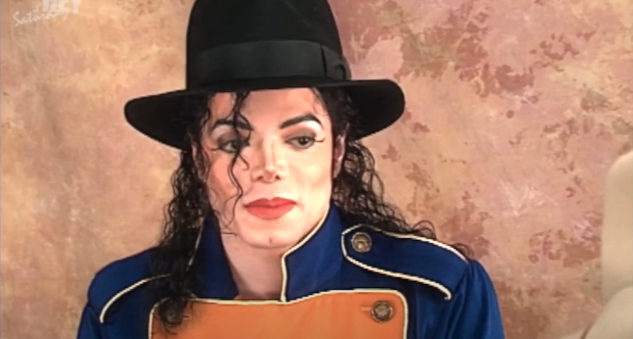Once upon a time, Michael Jackson’s wide-eyed, beaming smile and undeniable charm carried an innocence that made him instantly recognizable. He had the appearance of a prodigy and the demeanor of a born star as the Jackson 5’s young lead. But as the years passed, he started to look different, first in a subtle way and then in a big way. This shift raised the question, “Why did Michael Jackson get plastic surgery?” which has been asked with almost legendary tenacity for decades. The response isn’t straightforward. It navigates difficult ground, including trauma, disease, image, and identity, all of which are entwined under the strain of living in a harsh spotlight.
At one point, Jackson admitted that he had only had two rhinoplasties, mostly to help him breathe during shows. That might seem reasonable on paper. But his changing features told a more complex tale to anyone who paid even a passing glance. He narrowed his nose more and more. His once-rich brown skin tone faded into a porcelain glow, his jawline was redefined, and his cheekbones sharpened. These changes didn’t happen all at once. They were influenced by cultural forces, emotional scars, and medical conditions that affected not only his skin but also his mind.
| Attribute | Details |
|---|---|
| Full Name | Michael Joseph Jackson |
| Date of Birth | August 29, 1958 |
| Date of Death | June 25, 2009 |
| Profession | Singer, Dancer, Songwriter, Producer |
| Known For | “Thriller,” “Billie Jean,” Moonwalk, Cultural Icon |
| Medical Conditions | Vitiligo, Discoid Lupus Erythematosus |
| Cosmetic Surgeries | Multiple rhinoplasties, cheek implants, cleft chin, lip enhancements |
| Source | Wikipedia – Health and Appearance of Michael Jackson |
Jackson’s skin tone was one of the most frequently misinterpreted features of his metamorphosis. His complexion gradually lightened, which many people mistakenly believed to be an effort to hide his race. Jackson was actually found to have vitiligo, an autoimmune disorder that results in irregular skin pigment loss. His autopsy and medical records both confirmed that he had a patchy discoloration from the disease, which he attempted to control with depigmentation procedures. He used thick makeup and bleaching creams every day to cope, not to fit in.
He was battling discoid lupus erythematosus at the same time, which is another autoimmune disease that causes painful lesions and scarring, especially on the face. Dermatologists like Dr. Susan Strick believe that a large number of Jackson’s surgeries were probably reconstructive in nature, meaning they were performed to repair the damage rather than to achieve a desired aesthetic. In that regard, some procedures were medically necessary rather than motivated by vanity, especially in light of the visual demands of performing on a global scale.

There is a strong emotional undercurrent beneath the medical narrative. Jackson suffered long-lasting psychological scars from his early years, particularly from his relationship with his father. Several sources claim that Joe Jackson’s criticism of Michael’s appearance, particularly his nose, planted the seeds of self-doubt at a young age. Jackson reportedly admitted in private that he never felt “handsome.” Perhaps an internal echo of humiliation as a child was the source of that desire to change his appearance.
Jackson’s brief wife, Lisa Marie Presley, subsequently characterized him as someone who was constantly looking for approval. She implied that he struggled with a form of perfectionism that verged on torture, even though he never denied his Black identity. He had no desire to change who he was. Even if that version of himself was only in his head, he aspired to be the best version of himself.
Fame, especially the kind that Jackson had, distorts rather than just magnifies. A spectacle-hungry public consumed, criticized, and dissected his image in real time. Jackson became the face of what many perceived as excessive transformation, whereas celebrities like Cher, Joan Rivers, and even today’s influencers receive little criticism for their enhancements. The disparity in treatment was obvious. Social expectations were not only high, but frequently unachievable, particularly for a Black male artist.
Cosmetic surgery has become much more accepted, even celebrated, in recent years. Clinics proudly promote once-discussed procedures. Social media stars use sponsorships and hashtags to record their recuperations. But Jackson went through this process when the discussion was still teeming with shame and scrutiny. Under the microscope, his metamorphosis developed, and every characteristic—often devoid of empathy—became a talking point.
The number of surgeries Jackson had is a subject of wide-ranging reports. It was less than a dozen, according to some, and more than fifty, according to others. However, counting isn’t the point. The true cost was emotional rather than monetary. He was attempting to address a problem that is similar to our own with every cut and stitch: how to be seen and, more significantly, how to be accepted.
Intriguingly, “Man in the Mirror,” one of Jackson’s most moving songs, seems eerily self-referential in retrospect. Change is urged in the lyrics, beginning with the individual. Was he addressing his reflection, or was it a message to the audience? In his music, the distinction between confession and performance was frequently hazy.
Jackson passed away in 2009, but people are still fascinated by his appearance. Analysis articles and documentaries are still speculating. However, they hardly ever inquire as to why his metamorphosis initially captivates us. Is there a chance that we recognize something from his journey? a silent, unrelenting need for love. a wish to change the reflection in the mirror. Although Jackson had the means to go to great lengths to fulfill those desires, the desire is not alien.
Paradoxically, the field of cosmetic surgery that used to make fun of his appearance now makes money off of it. Jackson’s legacy is practically commodified by clinics such as Vanity Cosmetic Surgery, which list Jackson-inspired procedures in their portfolio. His before-and-after pictures, which are more clickbait than biographies, are constantly shared on forums and Instagram feeds.
